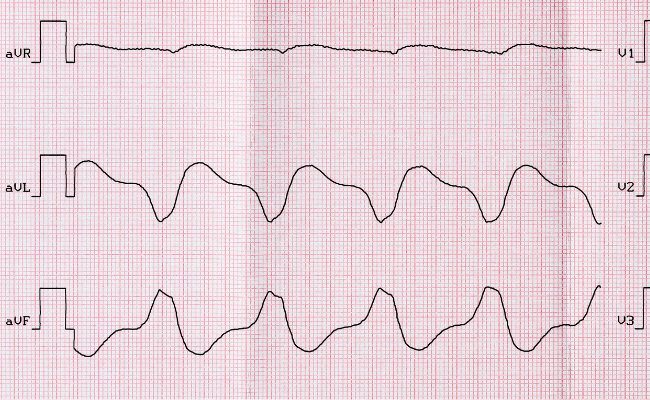How to Treat Nonsustained Irregular Wide Qrs Tachycardias?
- December 16, 2023
- No Comments

What is Non-sustained irregular wide QRS tachycardias?
Non-sustained irregular wide QRS tachycardias refer to a type of cardiac arrhythmia characterized by a rapid heart rate accompanied by irregular and widened QRS complexes on an electrocardiogram (ECG). In this condition, the heart beats at a faster-than-normal pace, and the electrical impulses responsible for coordinating the heartbeats exhibit irregular patterns. The term "non-sustained" implies that these episodes are typically brief, lasting for less than 30 seconds, and may spontaneously resolve without medical intervention. The widened QRS complexes indicate that the origin of the arrhythmia may be in the ventricles rather than the atria. Evaluation and diagnosis of non-sustained irregular wide QRS tachycardias are crucial for understanding the underlying cause, and treatment options may vary based on the specific arrhythmia and the patient's overall health.
Why is it a Concern?
This type of tachycardia can be concerning due to its unpredictable nature and potential to lead to more severe arrhythmias or cardiac events. The irregularity in heart rhythm may compromise the heart's ability to pump blood effectively, leading to symptoms such as dizziness, shortness of breath, and, in severe cases, syncope.
How Does Nonsustained Irregular Wide QRS Tachycardia Occur?
Nonsustained irregular wide QRS tachycardia is often associated with underlying heart conditions, such as structural heart disease, coronary artery disease, or previous heart attacks. Other contributing factors may include electrolyte imbalances, certain medications, or acute cardiac events. The irregularity in QRS complexes indicates a disruption in the normal electrical pathways of the heart, leading to chaotic impulses and an irregular heartbeat.
Treatment Solutions:
Treatment involves identifying and addressing underlying causes through medical history, physical examination, and diagnostic tests. Antiarrhythmic medications like amiodarone, propafenone, or flecainide may be prescribed. If medications are ineffective, electrophysiology studies (EPS) may be conducted to map the heart's electrical pathways. Catheter ablation is a minimally invasive procedure to eliminate abnormal electrical pathways, and an implantable cardioverter-defibrillator (ICD) may be recommended for those at a higher risk of life-threatening arrhythmias. The first step in managing nonsustained irregular wide QRS tachycardia is to identify and address any underlying causes. This may involve a comprehensive medical history, physical examination, and diagnostic tests such as echocardiography, stress testing, or coronary angiography.
- Medication Management: Antiarrhythmic medications may be prescribed to help regulate the heart's rhythm and prevent episodes of tachycardia. Medications such as amiodarone, propafenone, or flecainide may be considered based on the specific characteristics and underlying causes of the arrhythmia.
- Electrophysiology Studies (EPS): In cases where medications are ineffective or not well-tolerated, electrophysiology studies (EPS) may be recommended. During an EPS, catheters are inserted into the heart to map the electrical pathways and identify the source of the arrhythmia. This information helps guide further treatment decisions.
- Ablation Therapy: Catheter ablation is a minimally invasive procedure that aims to eliminate the abnormal electrical pathways responsible for the arrhythmia. During this procedure, a catheter is guided to the specific area causing the irregular heartbeats, and energy is delivered to disrupt the abnormal tissue. Ablation therapy has shown success in treating certain types of irregular wide QRS tachycardias.
- Implantable Cardioverter-Defibrillator (ICD): For individuals at a higher risk of life-threatening arrhythmias or sudden cardiac death, an implantable cardioverter-defibrillator (ICD) may be recommended. An ICD continuously monitors the heart's rhythm and delivers a shock to restore normal rhythm if a dangerous arrhythmia is detected.
Benefit Points:
- Improved Quality of Life: Effectively managing nonsustained irregular wide QRS tachycardia can significantly improve an individual's quality of life by reducing symptoms such as palpitations, dizziness, and shortness of breath.
- Prevention of Complications: Timely intervention and appropriate treatment can help prevent the progression of nonsustained irregular wide QRS tachycardia to more severe arrhythmias or complications, reducing the risk of adverse cardiac events.
- Individualized Treatment Approach: The identification of underlying causes and the use of personalized treatment plans, including medications, catheter ablation, or implantable devices, allow for a targeted and individualized approach to managing this complex arrhythmia.
- Risk Reduction: Catheter ablation and implantable devices, such as ICDs, have been shown to reduce the risk of recurrent arrhythmias and sudden cardiac death, providing a more secure and controlled cardiac environment for affected individuals.
- Advancements in Treatment Options: Ongoing research and advancements in electrophysiology and arrhythmia management continue to expand treatment options, offering new hope for individuals with nonsustained irregular wide QRS tachycardia. These advancements contribute to the development of more effective and targeted therapies.
Comments (0)